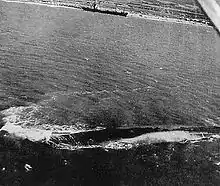Typhoon Marie (1954)
Typhoon Marie, as known as the Tōya Maru Typhoon (洞爺丸台風) in Japan,[1] was a typhoon that hit Japan in September 1954. Marie did a great deal of damage to Hokkaido, and the Tōya Maru (洞爺丸) train ferry sank due to the high waves and windstorm caused by Marie.[2] Because of it, JMA in Japan named the storm Tōya Maru Typhoon.
| Meteorological history | |
|---|---|
| Formed | September 19, 1954 |
| Dissipated | September 28, 1954 |
| Typhoon | |
| 10-minute sustained (JMA) | |
| Lowest pressure | 956 hPa (mbar); 28.23 inHg |
| Category 1-equivalent typhoon | |
| 1-minute sustained (SSHWS/JTWC) | |
| Highest winds | 140 km/h (85 mph) |
| Overall effects | |
| Fatalities | 1,361 |
| Missing | 400 |
| Areas affected | Japan |
| IBTrACS | |
Part of the 1954 Pacific typhoon season | |
Overview

Tropical storm (39–73 mph, 63–118 km/h)
Category 1 (74–95 mph, 119–153 km/h)
Category 2 (96–110 mph, 154–177 km/h)
Category 3 (111–129 mph, 178–208 km/h)
Category 4 (130–156 mph, 209–251 km/h)
Category 5 (≥157 mph, ≥252 km/h)
Unknown
In September 26, Typhoon Marie hit Japan. After passing Kyushu and Chugoku, Marie proceeded Sea of Japan northeast at a tremendous speed and hit Hokkaido.[1][3][4]
Due to Marie, some Seikan ferries such as Tōya Maru that departed from Hakodate Port, suffered a gale and high waves.[1] Tōya Maru sank, causing 1,139 people on it to die, resulting in enormous damage.[1][2]

Also, a large fire broke out in Iwanai, Hokkaido, partly due to the effect of Marie.[2][1] This fire called Fire of Iwanai (岩内大火) in Japan.
Name
JMA named Marie, which caused major damage mainly in Hokkaido, as Tōya Maru Typhoon, honouring the dead of the Tōya Maru.[2]
| Name | Number | Japanese name |
|---|---|---|
| Louise | T4523 | Akune Typhoon (阿久根台風) |
| Marie | T5415 | Tōya Maru Typhoon (洞爺丸台風) |
| Ida | T5822 | Kanogawa Typhoon (狩野川台風) |
| Sarah | T5914 | Miyakojima Typhoon (宮古島台風) |
| Vera | T5915 | Isewan Typhoon (伊勢湾台風) |
| Nancy | T6118 | 2nd Muroto Typhoon (第2室戸台風) |
| Cora | T6618 | 2nd Miyakojima Typhoon (第2宮古島台風) |
| Della | T6816 | 3rd Miyakojima Typhoon (第3宮古島台風) |
| Babe | T7709 | Okinoerabu Typhoon (沖永良部台風) |
| Faxai | T1915 | Reiwa 1 Bōsō Peninsula Typhoon (令和元年房総半島台風) |
| Hagibis | T1919 | Reiwa 1 East Japan Typhoon (令和元年東日本台風) |
See also
- Tōya Maru
- Fire of Iwanai
References
- "洞爺丸台風 昭和29年(1954年) 9月24日~9月27日". www.data.jma.go.jp (in Japanese). Retrieved August 7, 2020.
- 第2版,日本大百科全書(ニッポニカ), 百科事典マイペディア,デジタル大辞泉プラス,世界大百科事典. "洞爺丸台風(とうやまるたいふう)とは". コトバンク (in Japanese). Retrieved August 7, 2020.
{{cite web}}: CS1 maint: multiple names: authors list (link) - "デジタル台風:台風195415号 (MARIE) [洞爺丸台風] – 詳細経路情報(Google Maps版)". agora.ex.nii.ac.jp. Retrieved August 7, 2020.
- Company, The Asahi Shimbun. "朝日新聞デジタル:1954年 洞爺丸台風事故 – 北海道 – 地域". www.asahi.com (in Japanese). Retrieved August 7, 2020.
- "気象庁が名称を定めた気象・地震・火山現象一覧" (in Japanese). Japan Meteorological Agency. Retrieved February 20, 2020.